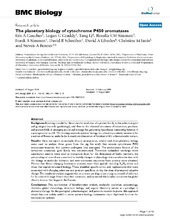| dc.description.abstract | Background: Joining a model for the molecular evolution of a protein family to the paleontological and geological records (geobiology), and then to the chemical structures of substrates, products, and protein folds, is emerging as a broad strategy for generating hypotheses concerning function in a post-genomic world. This strategy expands systems biology to a planetary context, necessary for a notion of fitness to underlie (as it must) any discussion of function within a biomolecular system. Results: Here, we report an example of such an expansion, where tools from planetary biology were used to analyze three genes from the pig Sus scrofa that encode cytochrome P450 aromatases–enzymes that convert androgens into estrogens. The evolutionary history of the vertebrate aromatase gene family was reconstructed. Transition redundant exchange silent substitution metrics were used to interpolate dates for the divergence of family members, the paleontological record was consulted to identify changes in physiology that correlated in time with the change in molecular behavior, and new aromatase sequences from peccary were obtained. Metrics that detect changing function in proteins were then applied, including KA /KS values and those that exploit structural biology. These identified specific amino acid replacements that were associated with changing substrate and product specificity during the time of presumed adaptive change. The combined analysis suggests that aromatase paralogs arose in pigs as a result of selection for Suoidea with larger litters than their ancestors, and permitted the Suoidea to survive the global climatic trauma that began in the Eocene. Conclusions: This combination of bioinformatics analysis, molecular evolution, paleontology, cladistics, global climatology, structural biology, and organic chemistry serves as a paradigm in planetary biology. As the geological, paleontological, and genomic records improve, this approach should become widely useful to make systems biology statements about high-level function for biomolecular systems. | en_US |



